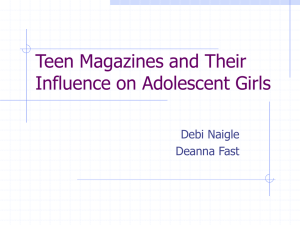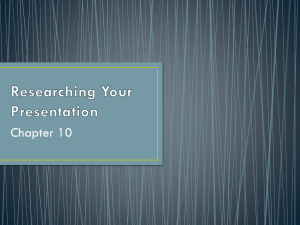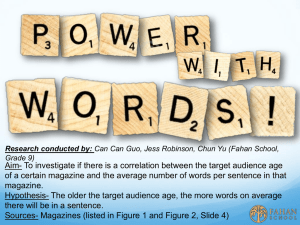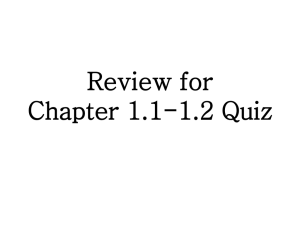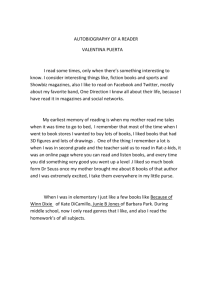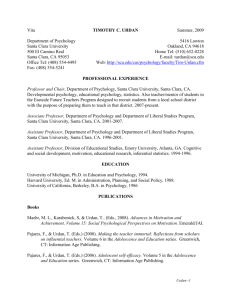Becky Jackson - Reading by Choice
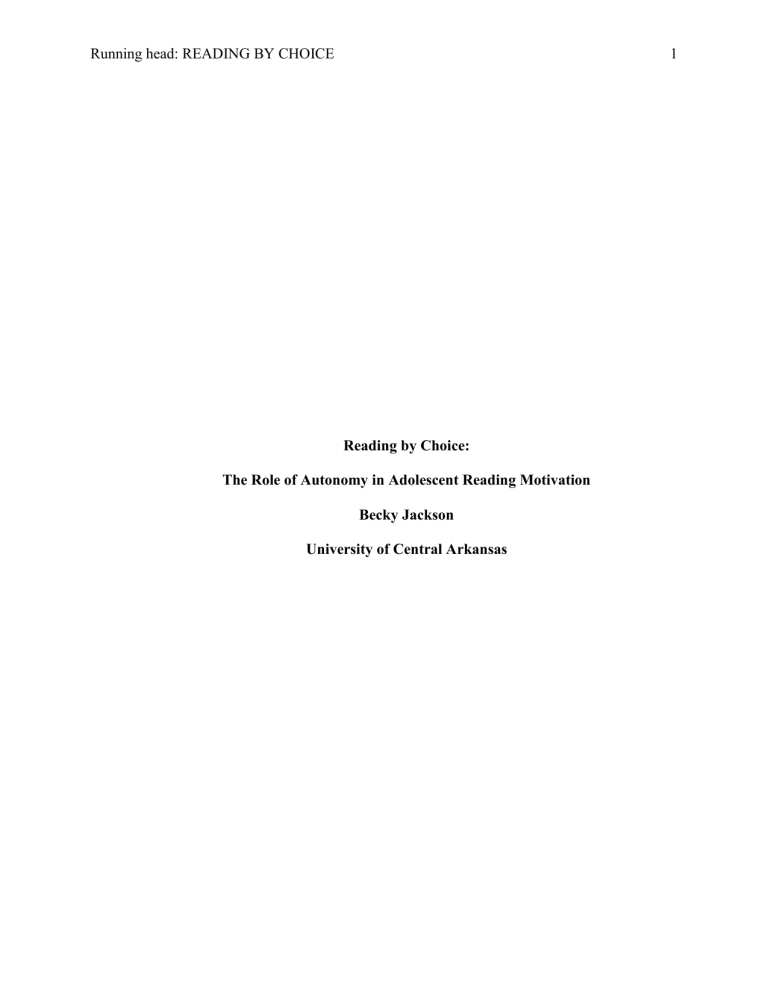
Running head: READING BY CHOICE
Reading by Choice:
The Role of Autonomy in Adolescent Reading Motivation
Becky Jackson
University of Central Arkansas
1
READING BY CHOICE
Reading by Choice:
The Role of Autonomy in Adolescent Reading Motivation
“Is it testable? What level is it? How many points is it worth?” These are questions not likely posed by parents or teachers during their own childhoods when choosing books to read.
The previous generation would have been more likely to simply ask “What is it about?”
Today, students are often limited to choosing from teacher-selected book lists, from books on a designated reading level, and from books with computer-based comprehension quizzes. Some researchers (Ivey & Broaddus, 2001; Moley, Bandre, & George, 2011; Worthy,
Moorman, & Turner, 1999) speculate that because choice affects motivation, these restrictions are part of the reason that children today are less inclined to read for pleasure or personal interest, and are more concerned about meeting school reading requirements as quickly and painlessly as possible.
Background
Research has shown that choice and personal interest are key factors in reading motivation (Edmunds & Bauserman, 2006). When Pitcher, Albright, DeLaney, Walker,
Seunarinesingh, Mogge, & Dunston (2007) asked students if teachers had ever done something they especially liked related to reading, several mentioned being allowed to choose what they would read. In schools, however, choice is affected by the limited quantity and diversity of materials that are available in the classroom or school library.
Research (Ivey & Broaddus, 2001; Moley et al., 2011; Worthy et al., 1999) suggests that reading motivation might be improved by providing a wider range of materials that better match students’ preferences. Edmunds & Bauserman (2006) emphasize that students should be
2
READING BY CHOICE 3 provided with reading materials on a wide variety of topics that correspond to their interests, and found that for many children that would mean books that are funny or scary, contain excellent illustrations, or increase their knowledge about topics of personal interest. Other materials based on typical students’ interests would likely include popular magazines and informational books on individual topics of interest such as sports, drawing, and animals (Worthy et al., 1999). In a large study of sixth grade readers, Ivey & Broaddus (2001) found that informational texts were a popular choice for students to read outside of school, but informational reading materials were barely mentioned as part of their school reading experiences.
Students perceive the value of a reading task based on how personally significant or interesting it is, and how it might help them with future goals (Malloy, Marinak, Gambrell, &
Mazzoni, 2013). Researchers have found that when readers feel that their reading materials can assist them in reaching personal goals, they place a higher value on them and become more motivated to read (Margolis & McCabe, 2006).
Research suggests that motivation might also improve if teachers allow students to choose from a wider variety of reading formats that they are using outside of school including the internet and magazines. Studies show that when allowed to choose from formats other than books, students often use internet resources to read information related to individual interests and goals. Many adolescent readers also enjoy magazines about the subjects they are interested in, including such topics as cars, sports, fashion, and people.
In one study, some boys who had indicated on written survey responses that they “never like to read” later revealed in interviews that they enjoy reading from magazines about hunting, fishing, or sports in their free time and discussing what they’ve read with family or friends (Pitcher et. al, 2007).
READING BY CHOICE 4
According to Pitcher et al. (2007), school programs designed to act as incentives can have the opposite effect on many adolescent readers because they are not in line with what effectively motivates them. Student interview responses from a study by Ivey & Broaddus (2001) showed that sixth graders were motivated by interesting materials or topics (39%) while Accelerated
Reader was mentioned by only 3% of students. Research has shown that extrinsic motivation can even have a negative impact on the amount of reading that students engage in (Schaffner,
Schiefele, & Ulferts, 2013) and does not lead to beneficial long-term results (Edmunds &
Bauserman, 2006). Intrinsic motivation, however, has been shown to have a positive effect on the volume of students’ reading (Becker, McElvany, & Kortenbruck, 2010) as well as their reading proficiency (Schiefele, Schaffner, Moller, & Wigfield, 2012). According to Urdan &
Schoenfelder (2006), teachers should strive to promote intrinsic motivation by reinforcing students’ sense of autonomy. They should encourage students to take ownership over their work rather than using controlling instructional methods like deadlines, threats, and competition
(Urdan & Schoenfelder, 2006). The body of research on practices that foster more positive school reading experiences for adolescents includes recommendations that center around honoring students’ voices, ownership, and choice in their literacy lives (Ivey & Broaddus, 2001).
Supporting intrinsic motivation and autonomy in the classroom is especially important during the upper elementary to middle school years (Urdan & Schoenfelder, 2006). Many educators notice a decline in students’ reading motivation, especially between fourth grade and the middle school years, and as a result, these students spend less time reading (Kelly & Decker,
2009). A study by Kelly & Decker (2009) found that reading motivation steadily decreased as students moved up from 6 th , 7 th , and 8 grades. In addition to grade level differences in motivation, researchers have found that there were clear gender differences in this trend, noting
READING BY CHOICE 5 that girls valued reading more as they got older while boys often lost interest in reading by late adolescence (Pitcher, et al., 2007).
One question educators should consider, however, is whether these students are truly unmotivated to read or are just reluctant to read from the limited range of choices that are available to them. Research shows that when teachers and schools make changes to classroom practices, motivation can improve if students are given more control over their learning and if learning tasks are centered around their interests (Urdan & Schoenfelder, 2006).
Research Question
A deficiency in the research is the limited number of studies measuring the impact on adolescent reading motivation when students are provided with more choices and autonomy. The purpose of this study was to investigate the following question:
Is there an impact on adolescent reading motivation when students are allowed to choose from a larger selection of materials and formats based on individual interests, and are given a reprieve from the quizzes and point requirements of their school’s incentive program?
The expected outcome of this study was that when provided with more appealing reading materials to choose from, and when given the autonomy to determine what they will read, including formats and texts that are not “testable,” adolescent-age students who are identified as the least motivated readers will exhibit improved intrinsic motivation toward reading.
Method
Participants and Setting
A classroom literacy teacher administered a revised version of the Motivation to Read
Profile (MRP) developed by Gambrell et al. (1996) to two classes of students in the fifth grade at a small, rural public school. Over 70% of students at the school are from socio-economically disadvantaged homes and the majority of the students are white. Both groups having the same
READING BY CHOICE 6 literacy teacher helped to limit variables that might occur because of differences in teaching style or classroom library.
Materials and Procedures
The Motivation to Read Profile was used as a pre- and post-test both before and after modifications were made to the reading program requirements and range of available materials to students in the experimental group. The MRP is a group-administered survey instrument that was made to assess students’ individual perceptions of the value of reading as well as their perceptions about themselves as readers (Gambrell et al., 1996). This self-concept aspect of reading motivation is important because the more confidence students have in a learning task, the more time and effort they will be willing to put into it (Urdan & Schoenfelder, 2006). On the other hand, adolescent readers can lose reading motivation if they think that a literacy activity is too challenging for them (Pitcher et al., 2007).
A revised version of the Motivation to Read Profile (MRP-R) developed by Malloy et al.
(2013) was used in this study. The revised survey was designed to reflect new digital literacies and includes questions in the conversational interview related to electronic reading sources
(Malloy et al., 2013). The conversational interview part of the MRP-R is conducted individually to guide conversations and questions about students’ individual reading interests (Malloy et al.,
2013).
When the MRP-R was given at the beginning of the study, the scores in the first class of
5 th
grade students ranged from 46 to 83 percent. The five lowest scores ranged from 46 to 64 percent. This group of students served as the control group used for comparison with the least motivated readers in the experimental group. The control group continued reading from the usual materials under the usual restrictions dictated by the school’s grading system and computerized incentive and quiz program (in this case, Accelerated Reader).
READING BY CHOICE 7
The MRP-R scores in the other group of 5 th
graders ranged from 61 to 89. The lowest five scores ranged from 61 to 69 percent. These five students became the experimental group of students who participated in the alternative reading experiences. The experimental group of students was provided with additional reading materials to supplement the AR books available in the school and classroom library. In addition, these students were interviewed individually to determine some specific interests using the conversational interview portion of the MRP-R, and were assisted in finding some related informational books, magazines, and internet sites based on their individual goals and interests.
The other variable was that the experimental group did not have an Accelerated Reader point requirement for the period of the study. They were not required to take Accelerated Reader quizzes and didn’t need to choose from a certain reading level when selecting materials. Instead, the experimental group simply read what was interesting to them based on their own choices. At the end of a four-week period, the MRP-R was administered again to determine if students’ attitudes toward reading had changed.
Findings
Conversational Interviews and Observations
The interviews produced some powerful qualitative data regarding the students’ attitudes toward reading and helped guide the researcher in finding reading materials to match their individual preferences. One student in the experimental group, Jarrett, responded on the initial survey that spending time reading is “boring” and libraries are “a boring place to spend time.” Of all the students interviewed, Jarrett demonstrated the most self-awareness about his true reading interests. In his conversational interview, he shared that he usually only cares to read about three topics: hunting, fishing, and football. He mentioned that “they only have five football books” in the school library and he had already read every one of them. He used his new flexibility in
READING BY CHOICE 8 reading choices to read about hunting in magazines and chose issues on football from the selection of Sports Illustrated magazines that were made available. He also read about the
Arkansas Razorback football team on the internet on a computer in the library.
Jarrett also used some of his reading time to work toward his goal of obtaining a state hunter’s education card by reading some of the information he would be tested on from the
Arkansas Game and Fish Commission website. Other times, he chose to read from hunting and fishing magazines that were made available to him. He had answered in the conversational interview that he expected to read about hunting and fishing when he is an adult.
Tori shared that she likes to read adventure stories and westerns and reads her mom’s magazines at home. She said she also enjoys reading about animals and about her favorite TV shows. When asked in the conversation interview what kind of reading she will do as an adult, she responded that she will read magazines and Louis Lamour westerns like her mom. When asked what teachers could do to make reading more enjoyable, she replied “let us read whatever we want.” Tori expressed an interest in reading about haunted places during the week of
Halloween. She had become interested in it because of a TV show her brother was watching. She found a website where she read a story about a haunted house in Arkansas.
Ethan had mentioned in his conversational interview that he enjoyed science fiction and funny stories or comics. He said that in his free time he chooses to read books that are at a lower level and “slightly funny.” He initially wanted to continue reading from the Star Wars series he had been reading recently, but one day he suddenly put the book down and looked around. He explained that he wasn’t interested in the series anymore. When reminded that he could choose anything he’d like to read, he remembered that he had enjoyed the Big Nate series of books that were in the library. When asked why he hadn’t been reading them, he replied “I had to get my
READING BY CHOICE 9
(Accelerated Reader) goal up” and explained that he had been unable to choose one of those books because they were below his designated reading level. He identified them as “funny” books rather than mysteries.
Michael, whose survey responses indicated a low reading self-concept, also chose reading materials that helped him in his individual goals. When asked in the conversational interview about what type of reading he does at home, he expressed that he was very interested in a game called Minecraft. He was able to locate combat handbooks that taught him how to make forts, armor, weapons, and traps in order to succeed as a warrior in the game. He also spent time on websites learning tricks and tips to use when playing Minecraft.
On the survey, Eric responded that spending time reading is “really boring.” During the conversational interview with Eric, he said that he usually finds out about books he might like to read from a list of recommendations on the computer, but complained that “half the books it suggests aren’t in the library.” Eric often had a hard time figuring out what he was interested in or sticking with any reading material or topic or long. He seemed most engaged after being introduced to a
Ripley’s Believe It or Not book. He was so intrigued with the hundreds of bizarre photos and captions from around the world that he checked out a whole stack of Ripley’s books from the library.
Data
The following tables and graph show the results of the MRP-R survey given as a pre-test and post-test for students in each group. Also shown are the group averages and the amount of change over the period of the study.
READING BY CHOICE
Student 1
Student 2
Table 1: Control Group Scores on MRP-R
Pre-Test Post-Test
46
58
50
49
Student 3
Student 4
Student 5
Average
59
64
64
58.2
69
65
53
57.2
Table 2: Experimental Group Scores on MRP-R
Pre-Test Post-Test
Student 1-Michael
Student 2-Eric
Student 3-Ethan
Student 4-Jarrett
Student 5-Tori
Average
61
63
65
69
69
65.4
65
80
70
86
96
79.4
Change
+4
-9
+10
+1
-11
-1
Change
+4
+17
+5
+17
+27
+14
10
READING BY CHOICE 11
Bar Graph: Group Averages on MRP-R
60
50
40
30
20
10
0
90
80
70
Pre-Test
Post-Test
Control Group Experimental Group
Discussion
The average increase in the reading motivation of students in the experimental group, as measured by the MRP-R, was an increase of 14 percent from the pre-test to the post-test. Two students showed a modest improvement of four or five percent, while the other three students showed a substantial increase of between 17 and 27 percent.
The students in the control group showed an average change in reading motivation of a one percent decline. Three students went up by one, four, and ten percent while the other two students showed a decrease in reading motivation of 9 and 11 percent.
Overall, 8 out of the 10 students who scored lowest on the MRP-R pre-test showed an increase in reading motivation over the four week period, but the experimental group showed
READING BY CHOICE 12 more substantial increases. The difference between the two groups on the amount of change between the pre-test and post-test, 15 percent, is significant enough to warrant further research.
Limitations of the Study
Some unanticipated influences could have played a role in the results of this study. In addition to changes in the materials available and the autonomy given to the students in the experimental group, there was also the factor of having conversations with a teacher about their interests and reading preferences, and conversations with peers in their group. The conversations and attention paid to the students’ reading interests could play a role in increasing motivation, but was not part of the factors studied.
Another limitation is that the study only included five students in the experimental group.
It would be more conclusive to use a larger sample size in future research. A question about the study is whether the results would be replicated in a larger school and a community with a higher socio-economic status. The number and diversity of materials in the library for this study was likely much smaller than what is available in larger, more affluent schools where there might be a larger selection of informational texts that match students’ individual interests even when they are required to read from texts with comprehension quizzes.
Implications and Future Research
A possible implication from these results is that the variables introduced have a greater effect on some students than others. Future research could investigate whether the changes introduced to the experimental group led to greater motivation gains for students like Jarrett because he had a clear sense of what his reading interests were. Future research should consider not only the overall merits of using reading incentive programs, but the effects on particular demographics of students.
READING BY CHOICE 13
Incentive programs like Accelerated Reader are a central part of many school reading programs, and can be a practical tool to help teachers monitor the volume of students’ reading and find texts that are on their level. These programs may benefit some ages and demographics of readers, particularly in the primary grades. Adolescents, however, especially those who are unmotivated readers, may respond differently to the structure of incentive programs. This age group may have a greater need for choice and autonomy and may benefit from a greater variety of reading materials and formats that are not valued by these programs. Research suggests that adolescent boys, in particular, may respond negatively to reading restrictions and respond more positively to having more control over their selections including informational texts and magazines as well as internet sites on topics of interest. In small schools with low-income students, access to a wide variety of materials on a particular topic of interest may be even more limited so using free resources like the internet could have even more of an impact.
The focus on text complexity in the Common Core State Standards might prompt teachers to exert more control over students’ reading choices in order to make sure they include rigorous material. An implication from this study, however, is that educators who wish to increase adolescents’ reading volume and engagement should incorporate more time for students to choose texts, formats, and topics that are personally meaningful in addition to texts that are chosen by the teacher for instruction and meeting standards. In terms of reading engagement and comprehension, a student who is half-heartedly going through the motions of reading awardwinning literature to meet a requirement is no better off than a reader who is enthusiastically invested in a favorite magazine .
READING BY CHOICE 14
References
Becker, M., McElvany, N., & Kortenbruck, M. (2010). Intrinsic and extrinsic reading motivation as predictors of reading literacy: A longitudinal study. Journal of Educational
Psychology, 102 (4), 773-785.
Edmunds, K. M., & Bauserman, K. L. (2006). What teachers can learn about reading motivation through conversations with children. The Reading Teacher, 59 (5), 414-424.
Gambrell, L.B., Palmer, B.M., Codling, R.M., & Mazzoni, S.A. (1996). Assessing motivation to read. The Reading Teacher, 49 (7), 518-533.
Ivey, G., & Broaddus, K. (2001). "Just plain reading": A survey of what makes students want to read in middle school classrooms. Reading Research Quarterly , 36 (4), 350-377.
Kelley, M. J., & Decker, E. O. (2009). The current state of motivation to read among middle school students. Reading Psychology, 30 (5), 466-485.
Malloy, J. A., Marinak, B. A., Gambrell, L. B., & Mazzoni, S. A. (2013). Assessing motivation to read: The motivation to read profile-revised. The Reading Teacher, 67 (4), 273-282.
Margolis, H., & McCabe, P. P. (2006). Motivating struggling readers in an era of mandated instructional practices. Reading Psychology, 27 (5), 435-455.
Moley, P., Bandre, P., & George, J. (2011). Moving beyond readability: Considering choice, motivation, and learner engagement. Theory Into Practice, 50 (3), 247-253.
Pitcher, S. M., Albright, L. K., DeLaney, C. J., Walker, N. T., Seunarinesingh, K., Mogge, S., &
Dunston, P. J.
(2007). Assessing adolescents' motivation to read. Journal of Adolescent &
Adult Literacy, 50 (5), 378-396.
Schaffner, E., Schiefele, U., & Ulferts, H. (2013). Reading amount as a mediator of the effects of intrinsic and extrinsic reading motivation on reading comprehension. Reading Research
Quarterly, 48 (4), 369-385.
Schiefele, U., Schaffner, E., Moller, J., & Wigfield, A. (2012). Dimensions of reading motivation and their relation to reading behavior and competence. Reading Research Quarterly,
47 (4), 427-463.
Urdan, T., & Schoenfelder, E. (2006). Classroom effects on student motivation: Goal structures, social relationships, and competence beliefs. Journal of School Psychology, 44 , 331-349.
Worthy, J., Moorman, M., & Turner, M. (1999). What Johnny likes to read is hard to find in school. Reading Research Quarterly, 34 (1), 12-27.
READING BY CHOICE 15



